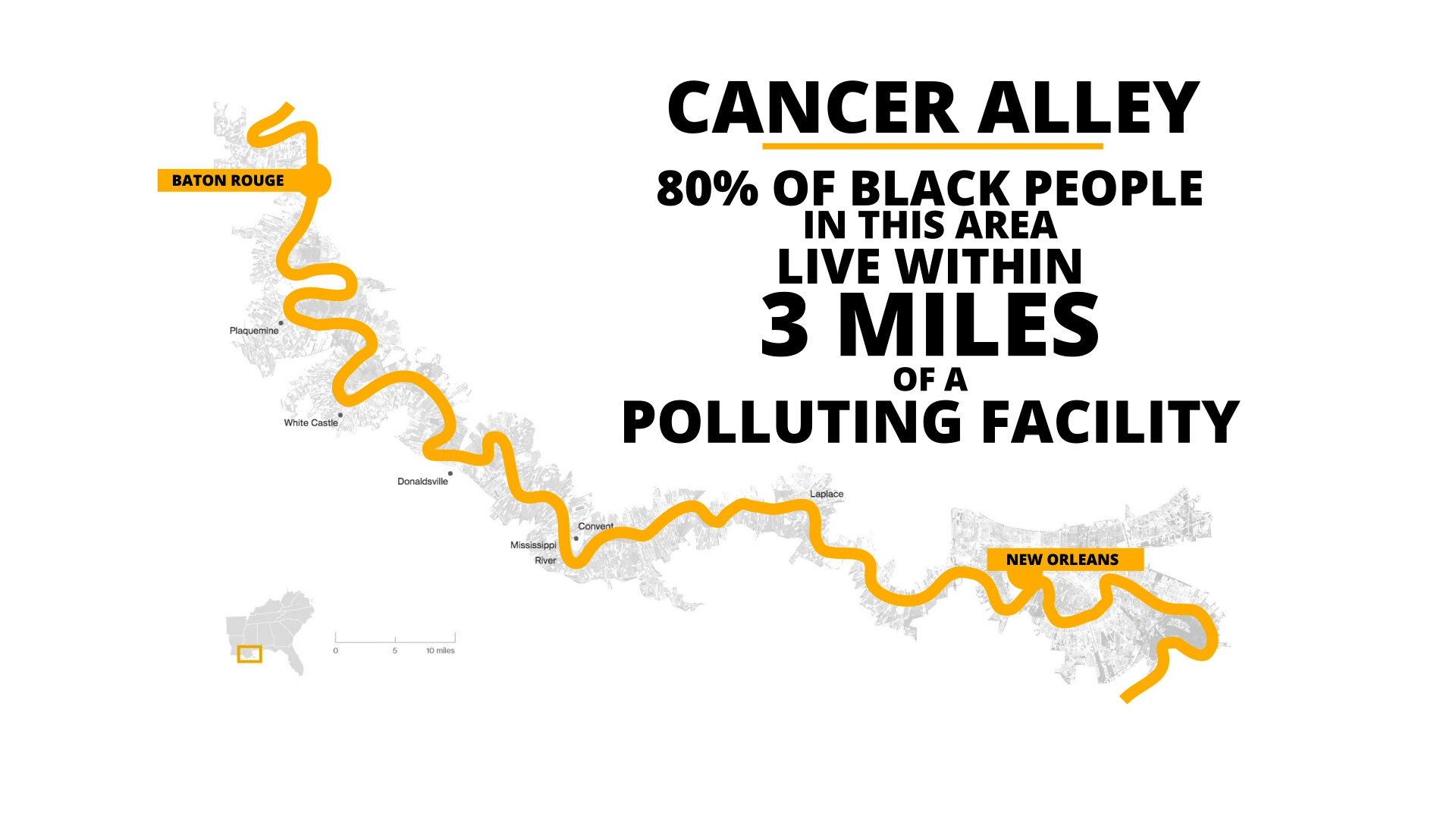Where does it go? Environmental Justice
Welcome to Changing Tides Foundation’s Where Does It Go? Series where we explore where things go when they leave our hands so that we can learn more about our impacts on the environment. So far in this series, we have explored everything from: food waste, clothes and recycling to motor oil. In this special edition of Where Does It Go? we explore this super important topic of WHO is most affected by air, water and land pollution in the US. This latest episode is all about ENVIRONMENTAL JUSTICE.
To tell this story, we called up our friend Kristy Drutman, also known as Brown Girl Green, who has dedicated her life to raising awareness about and fighting for environmental justice, to help us better understand the topic of Environmental Injustice and how we got here.
It all starts with environmental racism which is defined as any policy, practice or directive that, whether intended or unintended, differentially affects or disadvantages individuals, groups, or communities based on race or color. It stems from policies and practices that negatively affect people’s ability to have a healthy & clean environment based on their race and ethnicity. This is what we will focus on.
It is indisputable that pollution and climate change disproportionately affect BIPOC communities. But why? Lets do a quick history lesson, it started with white colonialism, which displaced indigenous people from their lands and created governmental policies that have made reservations key dumping and storage sites for toxic waste and fossil fuel development. Remember the Dakota Access Pipeline? Projects like that and drilling for oil in the Arctic Refuge are just a few key examples of continued threats to the land, air, and water of Indigenous communities across this country.
And we can’t forget about Redlining which is a system of racist housing and finance policies that discriminates against people based on where they live. Although Redlining was expressly banned in 1968, similar discriminatory practices still exist today, leaving communities of color disproportionately vulnerable to social and environmental factors. Examples include directing banks to deny poorer and majority black and hispanic communities access to mortgages; and loans prioritizing infrastructure development to predominantly white communities.
Here’s some context: White families have nearly TEN TIMES the wealth of black families and more than EIGHT TIMES that of Hispanic families. Mind-blowing, RIGHT? Much of this can be attributed to redlining. Environmental racism leaves people with an impossible choice - either build a healthy economy or create healthy communities. The way our country currently stands, you can’t have both.
Speaking of health, let’s talk about COVID-19. It’s no secret that people of color are dying from COVID at disproportionately higher rates than whites. WHY, you ask? Well, they are more exposed to air pollution, which is a mix of hazardous gasses like Nitrogen Oxide and Chlorine and particulate matter like smoke, ash, soot, construction debris. Both short and long-term exposure to particulates has been associated with a systemic impact on the human body: enhancing oxidative stress, acute inflammation, and respiratory infection. Long-term exposure to particulates is associated with racial segregation, which is a result of…YOU GUESSED IT: REDLINING.
To put it simply, the air in low-income communities and black communities is being poisoned by polluting industries that make goods for mostly white people. Black people are exposed to 1.5 times more particulate than white people and hispanics have 1.2 times the exposure of non-hispanic whites.
Which brings us to Cancer Alley, the 100 mile stretch between New Orleans and Baton Rouge in Louisiana, which is home to a large number of petrochemical plants. 80% of black people in this area live within 3 miles of a polluting facility. Reserve is a mostly black town right next door to Denka, the only US plant that makes neoprene, (used for wetsuits, laptop sleeves, etc…) a synthetic rubber made using a chemical called Chloroprene which pollutes the air and is a likely carcinogen.
After the Denka plant opened in 1968, whites migrated out and blacks were offered home loans and great deals on land in the area (remember REDLINING?). It wasn’t long before the residents of Reserve began complaining of constant headaches, shortness of breath and widespread cancers. It took them decades to realize that it was most likely coming from the neoprene facility. Black Americans in Louisiana, especially those in cancer alley, suffer from much higher rates of cancer compared to state and national averages. To be exact, the area near the Denka Plant, has the highest risk of air pollution-caused cancer in the country, at nearly 50 times the national average.
It’s clear that people who have damaged lungs are more susceptible to COVID and the communities in Cancer Alley have been breathing air harmful to their lungs for decades which explains why St. John the Baptist parish, where Reserve is located, has the highest COVID-19 death rate of any county in the US with a population over 5,000.
In the summer of 2020, millions of Americans stood in solidarity against the systemic racism that has plagued America. As people protest against police brutality and chant Black Lives Matter, the reality is that many BIPOC are being poisoned in their own homes and schools. The truth is, long before the phrase “I can’t breathe” became the rallying cry for protests against police brutality, BIPOC have been choking and dying from air pollution (Ahumad Arbery lived in Brunswick, Georgia, a community near 4 polluted superfund sites and 15 hazardous sites). How do we preserve the lives of BIPOC who are experiencing the slow violence of a poisonous environment?
Even after corporations and governments are held accountable for their wrongdoings, their gross negligence leaves scars for years to come. The water crisis in Flint, Michigan is a textbook example of how environmental racism goes way beyond air pollution, and the same is happening in Newark, New Jersey. In Los Angeles, LatinX families are still dealing with poisonous lead contamination from the Exide battery recycling plant, even after the company was sued and lost.
As Americans, we should all be equally protected, regardless of class or race. And now that the veil has been lifted, we must get to work to demand a healthy, equitable environment for all Americans.
At Changing Tides Foundations, we don’t like to focus on just the problems without presenting solutions. So how can we all work to be part of the solution?
We can EDUCATE OURSELVES about local polluting industries that exist near our own communities and learn about how they affect Black, Indigenous, and communities of color. LISTEN, RESEARCH and LEARN.
We can GET INVOLVED with local and national organizations fighting for Environmental Justice. VOLUNTEER or DONATE.
Most importantly, we need to DEMAND ACCOUNTABILITY from local, state and federal government officials for environmental justice. This means WRITE LETTERS, SIGN PETITIONS and VOTE!
This fight for land, resources, and the right to a healthy life has existed for centuries for black and indigenous people of color, the time has come for us to stand up for marginalized communities across the nation.
A few organizations fighting for Climate and Environmental Justice:
Campaigns you can get involved with right now:
Resources to read/listen to:
https://www.buzzfeednews.com/article/piapeterson/food-desert-photographs-building-community-santiago
Colonial Genocide in Indigenous North America - Alexander Laban Hinton
Clean and White: A History of Environmental Racism in the United States - Carl A. Zimring
The Home Place: Memoirs of a Colored Man's Love Affair with Nature - J. Drew Lanham
Sources:
https://www.mironline.ca/climate-change-and-racism-a-case-study-of-redlining/
The Effects of Historical Housing Policies on Resident Exposure to Intra-Urban Heat: A Study of 108 US Urban Areas)
https://medicalxpress.com/news/2020-10-urban-air-pollution-covid-severe.html
https://www.theatlantic.com/politics/archive/2018/02/the-trump-administration-finds-that-environmental-racism-is-real/554315/
https://www.michiganadvance.com/2020/07/07/anti-line-5-activists-buoyed-by-national-pipeline-victories/
http://redgreenandblue.org/2020/07/12/environmental-justice-ahmaud-arberys-georgia-home-town-now-96-white-black-folk-got-moved-superfund-site/
https://insideclimatenews.org/news/29102020/california-agriculture-farmworkers-coronavirus
https://www.ewg.org/news-and-analysis/2020/09/study-more-125000-farmworkers-have-contracted-covid-19
https://www.nbcnews.com/news/nbcblk/unsafe-water-more-prevalent-communities-color-study-finds-n1060366
https://federalnewsnetwork.com/government-news/2020/10/minority-communities-question-election-year-push-by-epa/
https://phys.org/news/2018-10-flint-crisis-egregious-environmental-injustice.html
https://www.nrdc.org/newark-drinking-water-crisis
https://www.usatoday.com/in-depth/news/nation/2020/10/12/covid-racism-kills-black-americans-living-near-toxic-plants/3498180001/
https://www.theguardian.com/us-news/2020/apr/07/cancer-alley-coronavirus-reserve-louisiana
https://www.scientificamerican.com/article/past-racist-redlining-practices-increased-climate-burden-on-minority-neighborhoods/






